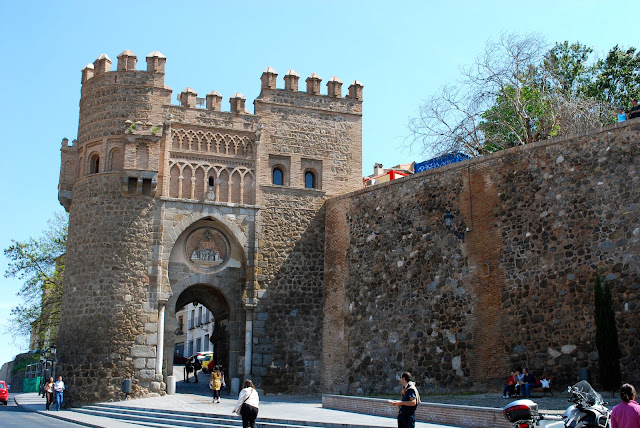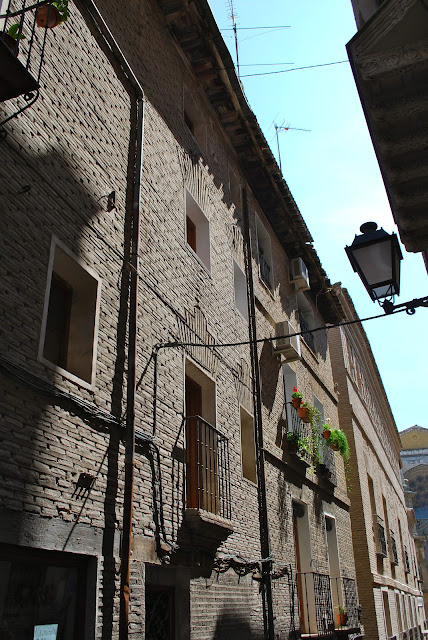 |
| Toledo |
Day 12 (Saturday, April 4th 2009)
After reluctantly waking up, I left the hotel in Cordoba just after 10:00 and began the long drive up to Toledo.
About 2 hours and 45 minutes into my drive, I stopped off at a city called Consuegra to see its famous windmills. Most of Spain's windmills are found in the province of La Mancha, which is located in the central part of the country. It has been said by many that the best examples of these restored windmills can be found in Consuegra, which has made the city quite famous. The windmills were introduced into Spain in the 16th century in order to help millers. The windmills were able to convert the wind energy and apply it to grinding grain, which was of huge importance during that time. Much to my surprise, I read that the windmills were actually used until the beginning of the 1980's.
As I approached Consuegra I could see the windmills lined up in the distance, towering over the city in a dramatic fashion. I parked my car next to the visitor center and then hiked up a hill, walking past the somewhat uninteresting castle until I reached the windmills. The windmills were fascinating to see, especially because there were so many of them!
 |
| Consuegra |
 |
| The windmills of Consuegra. |
 |
| Consuegra |
 |
| Castle of Consuegra. |
 |
| The windmills of Consuegra. |
 |
| The windmills of Consuegra. |
 |
| The windmills of Consuegra. |
 |
| The windmills of Consuegra. |
 |
| The windmills of Consuegra. |
 |
| The windmills of Consuegra. |
 |
| The windmills of Consuegra. |
 |
| The windmills of Consuegra. |
 |
| The windmills of Consuegra. |
 |
| The windmills of Consuegra. |
 |
| The windmills of Consuegra. |
 |
| The windmills of Consuegra. |
 |
| The windmills of Consuegra. |
 |
| The windmills of Consuegra. |
 |
| The windmills of Consuegra. |
 |
| The windmills of Consuegra. |
From Consuegra, I continued the drive onto Toledo. Luckily, I was able to find my hotel in Toledo much easier than I had in Cordoba; my navigation system took me directly there without any issues.
I had chosen to stay at Hotel Sol, which was located on a quiet street below the city walls. As a result, it was a long uphill hike up the historical center. The interior of my hotel room was decorated nicely, very clean, and included a large bathroom. As nice as it was however, the flip side to this was the fact that the hotel charged a ridiculous fee of 5 euros per hour (or 12 euros per day) in order to gain access to wireless internet. I had never in my life heard of such a ridiculous or steep fee before; all of the other hotels I had stayed at in Spain had included wireless at no additional cost, so this was a pathetic attempt on their end to make easy money.
 |
| Exterior of Hostel Sol in Toledo. |
 |
| Bathroom at Hostel Sol in Toledo. |
 |
| Bedroom at Hostel Sol in Toledo. |
 |
| Interior of Hostel Sol in Toledo. |
After settling into my room, I left and began the uphill walk into Toledo. The weather was quite warm at this point so it made the steep walk a little more difficult than I had expected. My initial impression of Toledo was that I liked it immediately. It was filled with lots of medieval cobblestone lined-streets, a beautiful mix of Jewish and Moorish architecture, and of course lots of people. As Toledo is only located 30 minutes by train from Madrid, most of the visitors are day-trippers so the city has a completely different vibe at night than it does during the daytime hours. The entire town was declared a World Heritage Site by UNESCO in 1986 for its extensive cultural and monumental heritage, allowing the Spanish government to forbid any modern exteriors. Toledo was the former capital of the Spanish Empire until Philip II moved the royal court to Madrid in 1561. Afterward the city went into a slow decline and was never again the powerhouse it had once been. I'm sure that this major change in history is probably what saved the city from modernization and why it currently retains so much of its original architecture. I for one was definitely thankful that Toledo lost its title of capital of Spain as the city was amazingly preserved and in great condition.
 |
| Toledo |
 |
| Toledo |
 |
| Toledo |
 |
| Toledo |
My first stop within the city walls was Plaza de Zocodover, which is the main square of the city center. As I sat down to gain my bearings, I saw that I was surrounded by hundreds of people who were either eating at one of the many cafes or just simply relaxing under the shade of a tree. From my vantage point on the bench I saw a kebab place called Birtat Doner which was located just up one of the narrow side streets from the square. I was quite hungry so I decided to spring for yet some more kebabs as I had had great luck with the inexpensive meal option several times prior on my trip. It only cost 3.5 Euros for one kebab, which was a great deal!
 |
| Plaza de Zocodover in Toledo. |
 |
| Plaza de Zocodover in Toledo. |
 |
| Plaza de Zocodover in Toledo. |
 |
| View from Plaza de Zocodover in Toledo. |
 |
| Toledo |
 |
| Toledo |
 |
| Toledo |
 |
| Toledo |
After filling myself up with lunch I walked through town, eventually reaching the cathedral. Toledo's cathedral, which was built between 1226-1493, is located in the center of the old town on the spot where a mosque once stood. I paid 7 Euros to enter the church (which I thought was quite steep), but its interior was listed as unique and amazing so I begrudgingly paid the high fee. Just as the guidebooks had indicated, the interior of the cathedral was quite magnificent. It was all things a church should be; light and airy with huge lofty ceilings and a floor plan that seemed to go on forever. The best part of my visit was the choir practice I happened to run into. There had to have been at least 100 voices singing whose sounds vibrated beautifully between the walls of the church. It was truly mesmerizing to hear the sounds of the choir and at times, felt almost surreal and as though I was listening to an amazing soundtrack from a major motion picture. It appeared that nearly every visitor in the church had stopped to listen to the music as it was too beautiful to ignore. This experience more than made up for the expensive entry fee and was definitely the highlight of my day in Toledo.
 |
| Exterior of Toledo's Cathedral. |
 |
| Exterior of Toledo's Cathedral. |
 |
| Exterior of Toledo's Cathedral. |
 |
| Exterior of Toledo's Cathedral. |
 |
| Exterior of Toledo's Cathedral. |
 |
| Exterior of Toledo's Cathedral. |
 |
| Exterior of Toledo's Cathedral. |
 |
| Interior of Toledo's Cathedral. |
 |
| Interior of Toledo's Cathedral. |
 |
| Interior of Toledo's Cathedral. |
 |
| Choir practice inside Toledo's Cathedral. |
Next I headed over to Santo Tome, which is a simple chapel that has been made famous for its El Greco painting The Burial of the Count of Orgaz. This painting by El Greco is considered by many to be his greatest work and was completed between 1586-1588. Unfortunately, I was unable to gain a decent up-close view of the painting as the small church was inundated with tourists and I wasn't about to shove my way to the front. However, I did manage to find a bench against a wall on the opposite side of the room which provided a good view of the painting. It's probably best to visit this church either early in the morning or in the late afternoon prior to closing in order to avoid the massive throng of visitors.
After seeing the famous painting, I headed back to the hotel room while stopping along the way for a few photo ops.
 |
| Toledo |
 |
| Toledo |
 |
| Toledo |
 |
| Toledo |
 |
| Toledo |
 |
| Toledo |
 |
| Toledo |
 |
| Toledo |
Along the way, I was able to view the exterior of the Alcazar. This building was originally used as a Roman palace in the 3rd century, then later restored under Alfonso VI and Alfonso X and renovated in 1535. Unfortunately, I was unable to tour the interior of the Alcazar as it had been closed for several years prior to my visit. Apparently, it is scheduled to open sometime during the later half of 2009 and will hold the National Military Museum.
 |
| Toledo's Alcazar |
 |
| Toledo's Alcazar |
 |
| Toledo's Alcazar |
 |
| Toledo's Alcazar |
 |
| View from Toledo's Alcazar. |
 |
| View from Toledo's Alcazar. |
I also stopped by the Santa Cruz Museum which is housed in a gorgeous Renaissance building and includes various works of art, including 15 El Grecos. Entrance into the museum was free but unfortunately I had arrived just prior to closing, so I only had about 20 minutes to tour before it closed. The small portion of the museum that I was able to see was enjoyable and actually quite interesting. I think I happened to tour one of the temporary exhibitions as I saw various objects from the 17th and 18th centuries including chamber pots, fancy porcelain dishes, and exquisitely designed comb and brush sets. Considering the museum is free for all to enter, I would definitely recommend allocating at least an hour or two to spend touring the museum.
 |
| Exterior of the Santa Cruz Museum. |
 |
| Exterior of the Santa Cruz Museum. |
Afterward, I eventually made my way back to the hotel as I was completely exhausted. I ended up napping for 1.5 hours.
 |
| Toledo |
 |
| Toledo |
 |
| Toledo |
I left the hotel again around 21:00 in order to eat dinner. After conferring with my guidebooks, I selected a place listed in Rick Steves called Pizzeria Pastucci. The restaurant was located within the walls of the city so it took me about 15 minutes to reach on foot. When I arrived, I was surprised to see that there were still a few empty tables and that I was the only tourist. I ordered a pizza topped with jamon and a pitcher of sangria. The food was delicious, inexpensive, and arrived quickly; everything I could have asked for.
 |
| Exterior of Pizzeria Pastucci in Toledo. |
 |
| Pizza at Pizzeria Pastucci in Toledo. |
As I left the restaurant and began walking back to the hotel, I noticed that the streets of Toledo were completely different at night than during the daytime. There was a much more relaxing vibe and because the weather was still relatively warm out, I took my time walking through the streets.
 |
| Toledo at night. |
 |
| Toledo at night. |
 |
| Toledo at night. |



















Very nice reading and I loved your photos. I know enough Spanish to get me into trouble. lol I'd love to visit Toledo someday. Thank you!
ReplyDelete